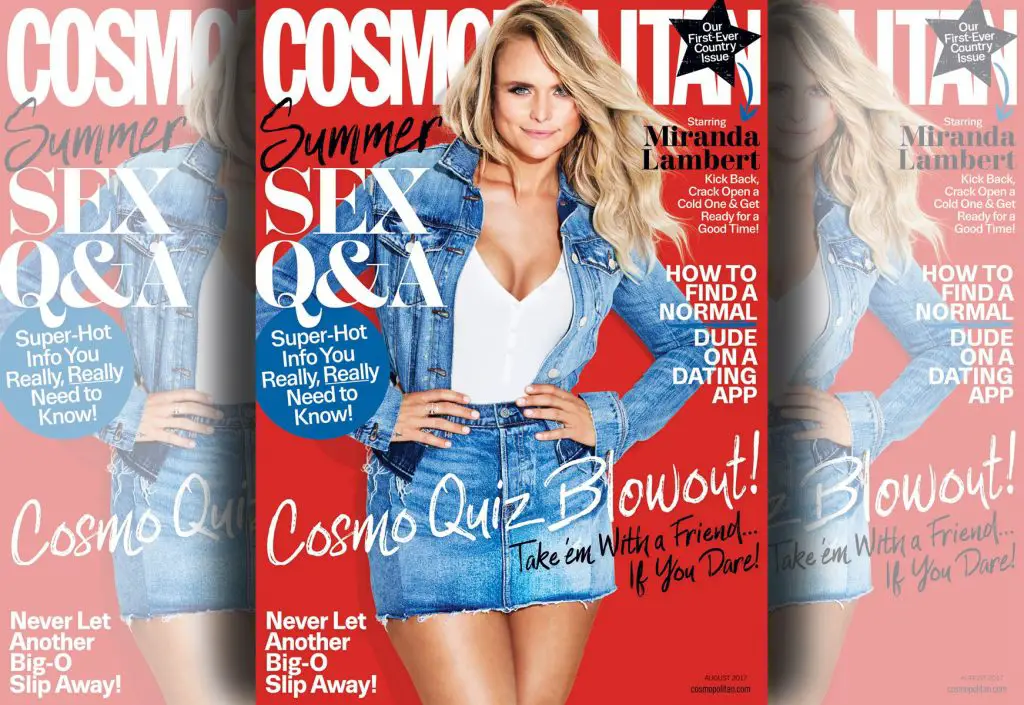Every few years, country music goes mainstream. It only takes one crossover hit from one icon with just the right kind of star power to break out of the genre’s typical demographic and make country culture trendy. Back in 2009, it was Taylor Swift, who hadn’t yet begun the evolution from country sweetheart to pop princess and still had every teenage girl eager to find out if the real Tim McGraw was as good as Swift’s debut single.
Now, with Sam Hunt’s record-breaking country hit “Body Like a Back Road” climbing the pop charts and Miranda Lambert gracing the cover of “Cosmopolitan” for their “First Ever Country Issue,” country appears to be making yet another mainstream comeback.
But here’s a question: Is this trend just a harmless excuse to dust off those cowboy boots and start calling denim shorts “daisy dukes,” or is it a form of cultural appropriation that glamorizes rural poverty and dilutes Southern culture into lighter, sleeker and overall more palatable fare for northern consumers?
At the same time, though country music may be a victim of cultural appropriation, the genre has been called out for being problematic for years. The largely white, male-dominated industry has battled accusations of sexism, homophobia and reinforcing patriarchal gender roles in the “bro-country” subgenre that all but dominates the charts these days.
While country music may appear to be a harmlessly repetitive genre celebrating cold beers and good times, its real reputation goes much deeper—and darker. New fans latching onto the genre’s increasing mainstream popularity now have two things to consider: Cultural appropriation, and what exactly they’re appropriating.
“Cosmo” Goes Country
Back before “Cosmopolitan” was synonymous with sex tips and vodka crans, it was literally synonymous with words like “sophisticated,” “progressive” and “worldly,” making the magazine’s August “Cosmo Goes Country” campaign something of a paradox.
Unsurprisingly, the attempts at “going country” involved little more than giving Miranda Lambert her second “Cosmo” cover and featuring articles like “Love Advice from Country Lyrics” and “Hot Dude + Country Vibe.”

However, country isn’t just a trend, style or even a genre. It’s a culture with its own values, history and struggles, and, like any culture, it can be appropriated. When a high-profile, New York-based publication like “Cosmo” slaps a Southern sweetheart on the cover and calls it country, it turns a rich regional culture into the fashion trend of the month.
This cosmopolitan approach to country glamorizes—if not completely overlooks—the plight of the genre’s origin. Pioneered by autobiographical songs like Loretta Lynn’s “Coal Miner’s Daughter” and Dolly Parton’s “Coat of Many Colors,” country music and its forerunning artists have a shared cultural history of rural poverty that is in many ways uniquely Southern, and certainly not particularly cosmopolitan.
Red-State State of Mind
The magazine’s tenuous alignment with country music is particularly troubling given “Cosmopolitan’s” increasingly prevalent political coverage. In recent years, the magazine has displayed a noticeably more pronounced interest in politics, rarely shying away from an overtly liberal perspective.
While there is nothing wrong with “Cosmo’s” political views nor their expression, they are made somewhat less convincing by the magazine’s choice to align itself with a culture, genre and industry that is still largely based around what are traditionally considered red-state mentalities and values.
Country music may be changing, but it remains a genre still largely driven by both lyrics and performers that “Vice” finds “unabashedly conservative, and nearly jingoistic.” Again, to each his own when it comes to political expression, but it seems problematic from both sides for “Cosmo” to promote a culture whose general politics and ideologies it actively protests. Not only does the magazine discredit its own political integrity by promoting a culture whose political rhetoric so greatly counters their own, but their selective adoption of country culture—completely ignoring the prominent political undertones in the genre—renders the move all the more appropriative.
Ultimately, “Cosmo’s” choice to “go country” as a vocally liberal publication in the midst of the current political climate reads as poorly thought out, poorly executed and, yes, potentially appropriative.
Skeletons in the Country Closet
While the conservative values and patriotism “Vice” finds in country music may be problematic from some perspectives, they are not necessarily inherently evil. For some, country music is merely a celebration of simple living and tradition.
Some of those traditions, however, are a little less flattering than mere patriotism. Southern culture has one of the darkest pasts in American history, and the region is still known for being significantly less progressive, politically and socially, than many of its northern neighbors.
Of course, no stereotype is ever universally true, but country culture is often still associated with conservative rhetoric and ideologies that ultimately promote bigotry and intolerance in a variety of forms, including racism, sexism and homophobia. Unfortunately, many of these unflattering values are still reflected in country music as well, whether in lyrics and performance, or in the industry itself.
Over the past two decades, country music has seen a significant decline in female radio play. Back in 2015, radio consultant Keith Hill brought this trend out of rumor status, with his incendiary recommendation that country radio stations take women out of rotation. “If you want to make ratings in country radio, take females out,” he said.
Not only are women fading from the industry, but their representation in its lyrics has also been a source of conflict. The 2015 hit “Girl in a Country Song” takes a satirical approach to female representation in country music, calling out the “bro-country” subgenre for its reinforcement of patriarchal gender roles and blatantly objectifying lyrics.
Additionally, it goes without saying that the industry suffers from a lack of LGBT representation. Back in 2015, the song “Girl Crush” by Little Big Town was pulled from a number of country radio stations due to backlash over perceived lesbian themes and imagery in the song’s lyrics.
Perhaps the most glaring absence in country music representation is from the black community. Despite its ties to a culture that was literally built by black Americans, country music remains dominated by white performers. Not only does the genre suffer from a lack of black representation, but it promotes a whitewashed perception of country culture, largely ignoring both the historical and present contributions of the black community.
Be Careful What You Appropriate
That is not to say country music is doomed to a lifetime of archaic ideologies and problematic rhetoric. Many of country’s biggest stars, like Kacey Musgraves, are actively trying to change the genre’s reputation and update the industry to reflect more progressive values.
Meanwhile, cultural exchange of art and ideas is important, and there’s nothing wrong with liking country music, no matter where you’re from. They’ve got some of the best breakup songs out there, and without it, we wouldn’t have Taylor Swift.
That said, before you dig out your cowboy boots and start saying “y’all,” take a minute to consider country as a culture, not just a fashion trend. Then, take a good hard look at the real values behind the dirt roads, trucks and cute accents. There’s more to it than cold beer and good times.

















